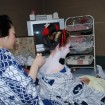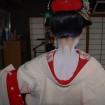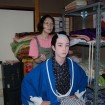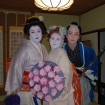Exploring Japan with Annie the Geisha, Michael the Samurai in Gion, Kyoto
The word Geisha is derived from ‘Gei’, which in Japanese means performance or entertainer, and ‘sha’, which means person, and dates back 400 years ago to the ‘Edo’ period. During this time the Geisha entertained at banquets and social gatherings by playing a Japanese guitar (called a Shamisen), and singing and giving dance performances. There is often a misconception by some that Geisha’s are prostitutes, but nothing could be further from the truth.
Geisha are refined and cultured girls and women who are highly trained in a variety of traditional skills. Besides playing the Shamisen, singing and dancing, the Geisha perform the Japanese tea ceremony, and are well-versed in the art of conversation. Many learn to speak English in order to entertain Western guests. The training involved in becoming a Geisha is very rigorous, and because of this the numbers of Geisha are declining. Few young women in today’s society are willing to devote themselves to such demanding training.
To become a Geisha, if accepted, a young girl must go through an apprenticeship that involves living with a head Geisha. This training period takes five to six years. During this time, the Geisha trainee must help with the chores and the running of the house, learn customs and social skills, and take music and dance lessons. After about six months, the trainee Geisha is called a maiko girl, and accompanies a Geisha on her appointments in order to become acquainted with customers. At about age 20, the maiko must make the decision to become a full-fledged Geisha or not. If a girl wishes to marry she cannot become a Geisha.
Geishas often live near temples and shrines, in areas are called hana-machi. Geishas entertain visitors at teahouses called o-chaya that are located near these areas. The o-chaya is not a shop that serves only tea or coffee, but rather a sort of banquet hall where rooms can be rented for dinner parties. It is usually a small Japanese style house with tatami (wooden) floors and Japanese style gardens. O-chayas are often where young Geishas live and work.
Today in Japanese hotels and restaurants Geisha entertain at banquets and socialize with guests. If you are staying at a hotel in Japan, you can arrange for a Geisha to attend a dinner party through the reservation desk. When you request a Geisha, it is important to be specific about what type of performance you want, because there are two different types of Geisha. One called ‘tchikata’ is usually a maiko girl and performs the traditional Japanese dance, and the other; usually an older Geisha is called ‘jikata’ and sings and plays an instrument. The costs for the services of a Geisha vary depending on the number the food, beverages, and the entertainment.
The role of the Geisha in Japanese society is a source of much curiosity for tourists. To tap into that curiosity, visitors can go to shops where they can dress in traditional Geisha Kimonos, have Geisha make up applied and then have a souvenir photo taken.









